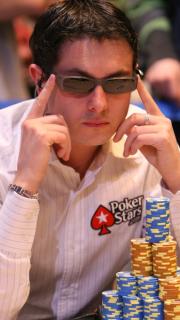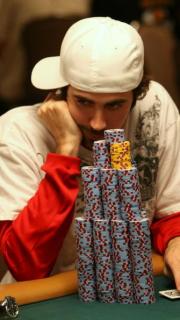Deep-stacked, No-Limit poker is one of the most complex and challenging varieties of the game.
It's not something every player will face, but if you do, it pays to be forewarned.
The main reason it's so complex is with deep stacks you're forced to play all three streets.
All-in confrontations are limited.
Each decision is a subtle chess move, and with any mistake you risk
losing not just a piece of your stack - you risk losing the whole thing.
In other words: deep-stacked poker is what separates the
gender-neutral term for adults from the gender-neutral term for
children.
All About Huge River Decisions
Deep stacks are defined as 200 BBs or more, and the biggest change in game-play is you actually have to play
easy cards tricks the turn and river.
If you're playing with 50-100 BB stacks, by the time you have a bet
and a raise on the flop, if you're committed it's always going in either
on the flop or the turn.
The river usually ends up being just a card you have to dodge with all the betting already finished.
In deep-stack poker, you have to make huge river decisions.
The pot is big and you still have money left to bet.
The only thing worse than facing a huge all-in turn bet is facing
that same-sized turn bet with more money left to bet on the river.
This is why pros love deep-stacked poker - because they can maximize their edge.

Deep-stacked poker is a thinking man's game.
Position Even More Important With Deep Stacks
It should be pretty apparent that position is the most important factor in poker.
If that isn't obvious to you, stop reading this article and go read this one.
Position becomes even more ridiculously important when the stacks are deep.
If your decisions were hard out of position before, just wait until
the pot is 150 BBs on the turn, you both have 300 BBs left in your stack
and you are out of position.
That decision is going to be very difficult. And that's just it: playing in position makes everything easier for you.
You get to have the final say whether you want to raise, check, bet or call.
When you're out of position, you're left guessing. And when you're
left guessing with deep stacks, you're going to end up making mistakes.
When you make mistakes, you lose money. It's as simple as that.
Deep Stacks Change Hand Values
Deep stacks change the value of hands drastically.
With a 20 BB stack, a hand like A-J can be very strong.

Deep stacks change hand value.
When you hit a flop, your opponent will likely call off your small stack with a potentially worse hand.
And when you're behind, you only lose that same small amount.
When the stacks are deep, your opponent is not going to want to put in a lot of money with a one-pair hand that you can beat.
So when you win, you win small. When you lose, though, you lose big.
Try playing three streets on ace-high boards with A-J. The times you win, it will be a small pot.
Those times you lose, you're going to lose a boatload.
Top Pair Hands Go Down in Value
That being the case, top pair hands go down in value. But that doesn't mean you should stop playing them.
They're still valuable - you just need to play smart, exercise pot control and of course maximize your time playing in position!
If top pair hands go down in value, which hands go up?
Big-pot hands do - hands like suited connectors and pocket
pairs. Hands that make sets, straights, flushes or full houses all
drastically rise in value.
With deeper stacks there's just more money to be won with big-pot hands.
In deep-stack situations, implied odds are through the roof because betting on the turn and river is almost guaranteed.
So in reality, a hand like 8
♥ 9
♥ is more valuable to you on the button than A
♣ T
♠ would be from early position.

The key is putting it all together.
Putting It Together
The "secret" is to put those two concepts together.
You want to play your big pots in position with big-pot hands.
You want to control the size of the pot when you have one-pair type hands, and you want to build big pots with big hands in position.
Let's look at a few examples.
Example 1
$1/$2 NL Full Ring. Effective stacks $600.
THe under-the-gun player limps as do two players from middle position. You raise to $10 with 7
♣ 8
♣ on the button.
All three players call. There is $43 in the pot.
The flop comes A
♣ T
♦ 6
♣. The UTG player bets out $20 and the other two limpers fold.
You raise to $65 and your opponent calls. There is $173 in the pot and the turn brings the 9
♦. UTG checks, you bet $135, he calls.
There is $443 in the pot now and the river comes 2
♠.
UTG checks, you go all-in for your last $410. Your opponent tanks and then calls.
He shows A
♦ 9
♠ and your straight rakes in a huge $1,200 pot.
Why Deep Stacks and Suited Connectors Go Hand in Hand
This hand is a great example of why deep stacks and suited connectors go hand in hand.
When you hit, you have the potential to win huge pots. When the stacks are deep, hand value normalizes.
It becomes less about the cards
marked cards and more about how you play them - skill is put back into the game.
When the stacks are deep you also have room to get creative with a wider range of hands because there is such a huge upside.
Weak Ace Out of Position is Doomed From the Get-Go

Weak aces out of position are doomed.
As for your opponent's play? Well, he was doomed from the get-go.
Playing a weak ace from out of position with deep stacks is always a recipe for disaster.
Also, he got married to his hand and you put him to tough decisions the entire way down.
Out of position, it's difficult to know where you stand and deep stacks worsen the situation.
If the stacks were a shallower, say 100 BB or less, chances are the money would have been in on the turn.
Because the stacks were deeper he was forced to call that would-be
all-in bet on the turn and yet another larger river bet to see if his
hand is good.
Now let's look at a top-pair style hand.
Example 2
$1/$2 NL Full Ring. Effective stacks $600.
UTG limps. You make it $8 with A
♣ Q
♠. He flat-calls and you take a flop heads-up. $19 in the pot.
Board comes A
♦ 7
♥ 8
♣. He checks and you bet $13. He flat-calls.
$45 in the pot now. The turn comes 2
♠. He checks, you check behind.
The river comes 6
♦. He bets out $35, you flat-call.
He shows 7
♦ 7
♠ and his set rakes in the $115 pot.
By being in position you control everything.
You eliminated the turn as a round of betting and only allowed him to
get one real street of value in. You have the last say in everything.
He, on the other hand, is in a tough spot. Out of position, he chose
to slow-play the flop and once you check the turn the pot is small.
He can't very well bet $200 into a $45 pot so he is forced to bet a reasonable amount.
An amount that, thanks to your expert pot control, is easily callable.
I know what you're thinking: If I play all my top pair hands super
weak and all my big hands strong, won't I be easily read by my
opponents?
They'll just fold when I bet big and call when I bet small.
True, if you always play that predictably.
Of course you should always mix up your play - so occasionally you
will have to bet three streets for value with TPTK or run up a
three-barrel bluff.
This is just a rough guide on how to play deep stacks.
It is not a cover-all, push chart. For deep-stacked poker, no such
chart exists. Deep-stacked poker is an art that needs to be played by
feel.
The only thing that can truly help you master deep-stack strategy is experience and the willingness to learn.
If you put in the time to review your hands played and constantly try
to come up with the optimum way to play hands, you'll be unstoppable.
Just remember:
The more you put your opponent to tough decisions and the more you
avoid tough decisions yourself, the more time you're going to spend
stacking chips and the less time you'll spend
second-guessing yourself.





